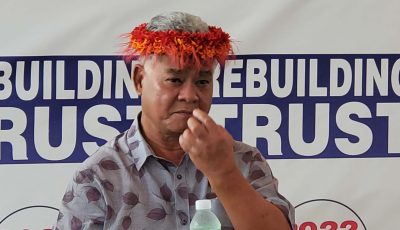Navy: Mass wasting of FDM mostly due to weather
Responding to federal and local concerns about the mass wasting of Farallon de Medinilla due to bombing, the U.S. Navy maintains this is largely due to typhoon and weather disturbances.
The Coastal Resources Management Office, now under the Bureau of Environmental and Coastal Quality, and the Environmental Protection Agency in 2013 wrote their concerns over the effect of bombing on the island’s mass wasting, and effect on near shore environment.
In their response to these comments, the Navy says they have provided this information in their final environmental impact statement for the Marianas Islands Training and Testing study area.
According to BECQ, satellite imagery and oblique photographs show significant changes to the morphology of FDM. The images make apparent mass wasting along the island’s eastern cliff lines, mass wasting on its land bridge on eastern side, and a recent sea cave collapse.
“The total loss of land mass on FDM since bombing commenced must be presented,” the bureau wrote.
To these concerns, the Navy pointed to dive surveys conducted since 1999 and a 2004 report concluding that although some damage could be directly attributed to ordnance impacts, “natural factors also contribute to the changes.”
“Examination of photographs from 1944 indicates that changes in the geological structure of the island by erosion and mass wasting…have been going on for decades,” the Navy writes.
According to the Navy, the dive surveys in 2004 were completed shortly after Typhoon Ting Ting, which passed through the Marianas in June and gave the opportunity to observe damage to the island and near shore environment of FDM.
According to the Navy, the dive studies show that from 2006 to 2012, there were “no visual evidence of abnormalities, damaged, or diseased coral” at FDM.
Also, no new submerged cliff blocks were observed between 2005 and 2013. Small- to medium-sized fresh rock fragments were observed yearly and were attributed to detonation impacts.
In 2007, “the first clear indication” of a detonation of a bomb on the seafloor was observed. The impact area was measured to be 100 square feet. The Navy says that in the next year, the impact area supported new growth of stony corals and algae.
The Navy also notes that the vast majority of unexploded ordnance observed in the water lacked fins and tail assemblies. According to the Navy, this indicates that the ordnance either skipped or ricocheted off of the island or were eroded or washed off FDM.
“Based on these direct observations of damage off the coast of FDM, the majority of disturbances to the seafloor sediments, substrates, and mass wasting of FDM can be attributed to typhoons and storm surges. Further, damage attributed to military training recovered within two to three years at the same rate of damage associated with natural phenomenon,” the Navy writes.



























